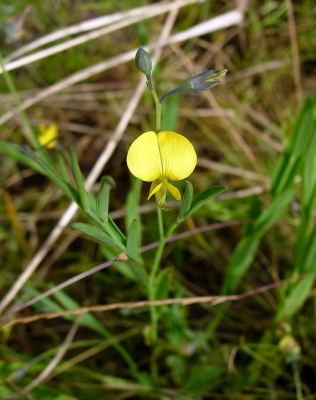Crotalaria glauca
Willd.
Fabaceae
Crotalaria amadiensis De Wild.
Crotalaria cylindroclados Baker f. & Martin
Common Name:
General Information
Crotalaria glauca is a very variable, annual or short-lived perennial plant growing from 30 - 100cm tall, occasionally as tall as 1.8 metres[
328- Title
- African Flowering Plants Database
- Publication
-
- Author
-
- Website
- http://www.ville-ge.ch/musinfo/bd/cjb/africa/recherche.php
- Publisher
- Conservatoire et Jardin Botaniques.
- Year
- 0
- ISBN
-
- Description
- Contains information on over 150,000 plant names (including synonyms) giving a description and habitat, plus a distribution map.
].
The plant is gathered from the wild for local use as food, and is very occasionally cultivated for this purpose[
46- Title
- Dictionary of Economic Plants.
- Publication
-
- Author
- Uphof. J. C. Th.
- Publisher
- Weinheim
- Year
- 1959
- ISBN
- -
- Description
- An excellent and very comprehensive guide but it only gives very short descriptions of the uses without any details of how to utilize the plants. Not for the casual reader.
,
].
Known Hazards
No specific mention of toxicity has been seen for this species, but many members of this genus are known to contain pyrrolizidine alkaloids, the most potent of which in this genus are monocrotaline, retrorsine and retronecine[
1309- Title
- The Leguminosae; A Source Book of Characteristics, Uses and Nodulation
- Publication
-
- Author
- Allen O.N.; Allen E.K.
- Publisher
- University of Wisconsin
- Year
- 1981
- ISBN
- 0-333-32221-5
- Description
- An amazing and comprehensive work, giving a brief guide to the many genera of the family Fabaceae and also the principle uses of the genus.
]. These alkaloids have a cumulative effect upon the body and, unless concentrations in a plant are high, occasional consumption is generally completely safe. Pyrrolizidine alkaloids are derived from amino acids including ornithine. Many of these alkaloids have pronounced hepatic toxicity, but the lungs and other organs may be affected as well. Mutagenic and carcinogenic activities of pyrrolizidine alkaloids have also been reported[
299- Title
- Protabase - Plant Resources of Tropical Africa.
- Publication
-
- Author
-
- Website
- http://www.prota.org
- Publisher
-
- Year
- 0
- ISBN
-
- Description
- An excellent on-line database with detailed information on over 3,200 species of useful plants of Africa.
].
Botanical References
Range
Tropical Africa - Senegal to Ethiopia, south to Angola and Mozambique.
Habitat
Grassland, widespread; deciduous woodland, open bushland; restricted to locally damp places in generally dry areas, also roadsides and cultivated ground; at elevations of 400 - 2,000 metres[
328- Title
- African Flowering Plants Database
- Publication
-
- Author
-
- Website
- http://www.ville-ge.ch/musinfo/bd/cjb/africa/recherche.php
- Publisher
- Conservatoire et Jardin Botaniques.
- Year
- 0
- ISBN
-
- Description
- Contains information on over 150,000 plant names (including synonyms) giving a description and habitat, plus a distribution map.
].
Properties
| Edibility Rating |      |
| Habit | Annual/Perennial |
| Height | 1.00 m |
| Cultivation Status | Cultivated, Wild |
Cultivation Details
Growing at low to medium elevations in the moist to drier tropics.
Plants in this genus generally prefer a sunny position, succeeding in dry to moist, well-drained soils[
200- Title
- The New RHS Dictionary of Gardening. 1992.
- Publication
-
- Author
- Huxley. A.
- Publisher
- MacMillan Press
- Year
- 1992
- ISBN
- 0-333-47494-5
- Description
- Excellent and very comprehensive, though it contains a number of silly mistakes. Readable yet also very detailed.
].
A highly variable species in habit[
308- Title
- Flora Zambesiaca
- Publication
-
- Author
-
- Website
- http://apps.kew.org/efloras/fz/intro.html
- Publisher
-
- Year
- 0
- ISBN
-
- Description
- An excellent online flora of plants from the Zambezi River basin. It lists a number of the plant uses as well as the habitats and botanical descriptions of the plants.
].
This species has a symbiotic relationship with certain soil bacteria; these bacteria form nodules on the roots and fix atmospheric nitrogen. Some of this nitrogen is utilized by the growing plant but some can also be used by other plants growing nearby[
1309- Title
- The Leguminosae; A Source Book of Characteristics, Uses and Nodulation
- Publication
-
- Author
- Allen O.N.; Allen E.K.
- Publisher
- University of Wisconsin
- Year
- 1981
- ISBN
- 0-333-32221-5
- Description
- An amazing and comprehensive work, giving a brief guide to the many genera of the family Fabaceae and also the principle uses of the genus.
].
Edible Uses
The leaves, flowers and pods are eaten[
46- Title
- Dictionary of Economic Plants.
- Publication
-
- Author
- Uphof. J. C. Th.
- Publisher
- Weinheim
- Year
- 1959
- ISBN
- -
- Description
- An excellent and very comprehensive guide but it only gives very short descriptions of the uses without any details of how to utilize the plants. Not for the casual reader.
].
Medicinal
None known
Other Uses
None known
Propagation
Seed - sow in situ. Pre-soaking the seed for 12 hours in warm water can help to reduce germination time.
If you have any useful information about this plant, please leave a comment. Comments have to be approved before they are shown here.





 Useful Tropical Plants Database 2014 by
Ken Fern,
web interface by
Ajna Fern
with help from
Richard Morris.
Useful Tropical Plants Database 2014 by
Ken Fern,
web interface by
Ajna Fern
with help from
Richard Morris.